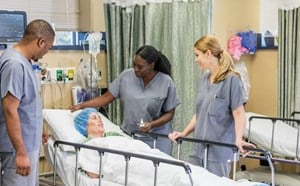
The Past, Present and Future of Observation Medicine
The Past, Present and Future of Observation Medicine: An Interview with Dr. Louis Graff IV
Christopher Caspers, MD
Department of Emergency Medicine
NYU Langone Hospital—Long Island
When did you first see the opportunity for observation medicine?
1984. My wife received a position at the University of Connecticut Medical School as a cardiologist, and I received a position as an emergency physician at the New Britain General Hospital (NBGH), which was about 15 minutes away. The NBGH ED was moderately busy (around 100,000 visits/year) and, in addition to working 40 hrs/week clinically, I was made the associate ED director and was responsible for quality of care. Each month, I reviewed and presented cases at our morbidity and mortality meeting, including missed diagnoses (eg, patient had chest pain and came back with myocardial infarction; patient had abdominal pain and came back with a perforated appendix). The patients were almost always low probability of a serious, dangerous disease (eg, MI, acute appendicitis), but not “no risk.”
I noticed that for many diagnoses such as syncope, abdominal pain, or chest pain, it was very variable whether the admitting service would let us “admit” a patient for work up. In many cases, they refused to admit and said we should “send the patient out.” But for me, as an emergency physician, I would agree that many of these cases were low risk but still needed a rule-out and/or work up. So, rather than just discharge the patient, we had two semi-private rooms (two beds and a bathroom) attached to the ED where I started managing select patients for brief periods overnight.
What challenges did you encounter early during the implementation of observation medicine? Were hospital leaders open to the concept? Were there political barriers? Did it take convincing of other stakeholders?
The opportunity for implementing observation medicine on a country-wide scale came about when ACEP leadership created sections of membership rules. I saw disaster medicine became a section, so I decided to start circulating and collecting signatures on a petition for an observation medicine section. I collected signatures at the national ACEP meeting and also by a mailing campaign to ACEP members. I also searched for any observation medicine research articles I could find and contacted the author or authors (who were often emergency physicians) to try and get them to sign onto the petition for an observation medicine section. I found out that those who had invested the time to do research in this area were often very interested in the section. A large proportion of our original 100 members were such physicians.
How has observation medicine changed over time?
Observation medicine was originally a “cult” concept. Most emergency physicians embodied the mindset “we want dispositions - why would you want to keep someone for overnight or for 24 hours?” But with time, it became an established practice as more joined onto the mission to get observation medicine codified, accepted, and even paid for. We established practice standards, met with many payors, and supported our fellow physicians around the country by setting up or improving existing observation medicine programs. We advocated for fellow physicians individually and through ACEP representation to get CPT codes approved to reimburse physicians when providing the additional observation services.
Unfortunately, the payors responded unexpectedly to the concept. They not only agreed to pay for observation services, but they also began auditing inpatient stays and started denying payment for inpatient cases that they said should had been provided through observation.
What are the largest challenges you see for the continued growth of observation medicine?
The payors are the biggest challenge. Our mission for implementing ED observation programs was to improve quality of care. To avoid a ‘failure to diagnose” or a “failure to treat” - that has been our focus. The payors’ focus was lowering their cost of care. Our research showing the value of observation medicine always showed improved quality of care and a lower rate of failure to diagnose or failure to treat. But it also showed that the direct costs of care were much lower than hospital admission. Once the payors saw this … bam! The payors not only agreed to pay for the observation service, they implemented audits to deny payment for inpatient admissions that they said should have been observations.
What is the future of observation medicine?
The future for observation medicine and emergency medicine is continuing to refine the issue of defining “who is sick.” Observation only works if the patient has a limited and focused evaluation and management and is discharged home if “ruled-out,” or admitted if “ruled-in.” To place patients in observation who are sick or have high intensity of services is essentially sabotage to observation medicine. This is not what “inpatient criteria” like Interqual or Milliman criteria determine, either.
Are you surprised at where we are today with respect to observation medicine as an area of focus within emergency medicine?
Yes. I thought the battle would be over by now.
Who has had the greatest impact on your professional career?
Besides my wife? Haha! Greg Henry, with all he did with the issue of failure to diagnose and failure to treat related to adverse clinical outcomes and risk of malpractice suit. And Jerris Hedges, whose research and academic career make him such a positive role model. He remains focused on supporting fellow emergency physicians in their efforts to improve emergency medicine quality. This includes supporting observation medicine and contributing chapters to my observation medicine textbook.
What are you going to do next?
I am presently not seeing patients but am still hard at work for my hospitals performing utilization review. I review electronic charts of patients who a nurse reviewer (who uses the Interqual system) is unable to support inpatient level of care. As a physician advisor for the utilization review committee, I am in a daily battle to prevent abuse of the observation medicine system/concept and advocate for the right level of care for our patients.


